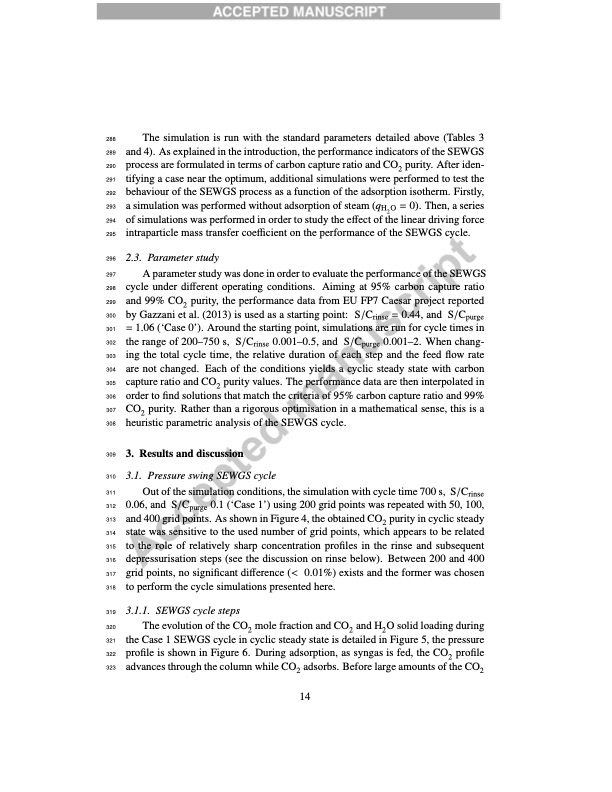
PDF Publication Title:
Text from PDF Page: 016
288 The simulation is run with the standard parameters detailed above (Tables 3 289 and 4). As explained in the introduction, the performance indicators of the SEWGS 290 process are formulated in terms of carbon capture ratio and CO2 purity. After iden- 291 tifying a case near the optimum, additional simulations were performed to test the 292 behaviour of the SEWGS process as a function of the adsorption isotherm. Firstly, 293 a simulation was performed without adsorption of steam (qH2O = 0). Then, a series 294 of simulations was performed in order to study the effect of the linear driving force 295 intraparticle mass transfer coefficient on the performance of the SEWGS cycle. 296 2.3. Parameter study 297 A parameter study was done in order to evaluate the performance of the SEWGS 298 cycle under different operating conditions. Aiming at 95% carbon capture ratio 299 and 99% CO2 purity, the performance data from EU FP7 Caesar project reported 300 by Gazzani et al. (2013) is used as a starting point: S/Crinse = 0.44, and S/Cpurge 301 = 1.06 (‘Case 0’). Around the starting point, simulations are run for cycle times in 302 the range of 200–750 s, S/Crinse 0.001–0.5, and S/Cpurge 0.001–2. When chang- 303 ing the total cycle time, the relative duration of each step and the feed flow rate 304 are not changed. Each of the conditions yields a cyclic steady state with carbon 305 capture ratio and CO2 purity values. The performance data are then interpolated in 306 order to find solutions that match the criteria of 95% carbon capture ratio and 99% 307 CO2 purity. Rather than a rigorous optimisation in a mathematical sense, this is a 308 heuristic parametric analysis of the SEWGS cycle. 309 3. Results and discussion 310 3.1. Pressure swing SEWGS cycle 311 Out of the simulation conditions, the simulation with cycle time 700 s, S/Crinse 312 0.06, and S/Cpurge 0.1 (‘Case 1’) using 200 grid points was repeated with 50, 100, 313 and 400 grid points. As shown in Figure 4, the obtained CO2 purity in cyclic steady 314 state was sensitive to the used number of grid points, which appears to be related 315 to the role of relatively sharp concentration profiles in the rinse and subsequent 316 depressurisation steps (see the discussion on rinse below). Between 200 and 400 317 grid points, no significant difference (< 0.01%) exists and the former was chosen 318 to perform the cycle simulations presented here. 319 3.1.1. SEWGS cycle steps 320 The evolution of the CO2 mole fraction and CO2 and H2O solid loading during 321 the Case 1 SEWGS cycle in cyclic steady state is detailed in Figure 5, the pressure 322 profile is shown in Figure 6. During adsorption, as syngas is fed, the CO2 profile 323 advances through the column while CO2 adsorbs. Before large amounts of the CO2 14PDF Image | High-temperature pressure swing adsorption cycle design for sorption

PDF Search Title:
High-temperature pressure swing adsorption cycle design for sorptionOriginal File Name Searched:
high-temperature-pressure-swing-adsorption.pdfDIY PDF Search: Google It | Yahoo | Bing
CO2 Organic Rankine Cycle Experimenter Platform The supercritical CO2 phase change system is both a heat pump and organic rankine cycle which can be used for those purposes and as a supercritical extractor for advanced subcritical and supercritical extraction technology. Uses include producing nanoparticles, precious metal CO2 extraction, lithium battery recycling, and other applications... More Info
Heat Pumps CO2 ORC Heat Pump System Platform More Info
| CONTACT TEL: 608-238-6001 Email: greg@infinityturbine.com | RSS | AMP |